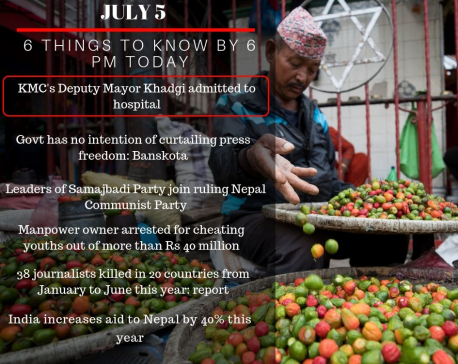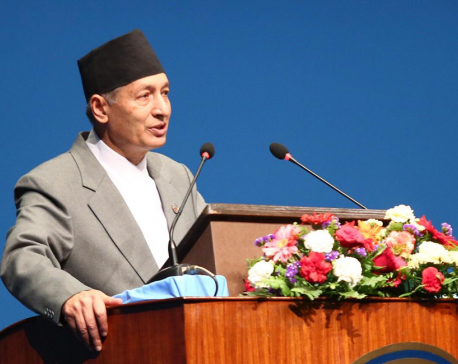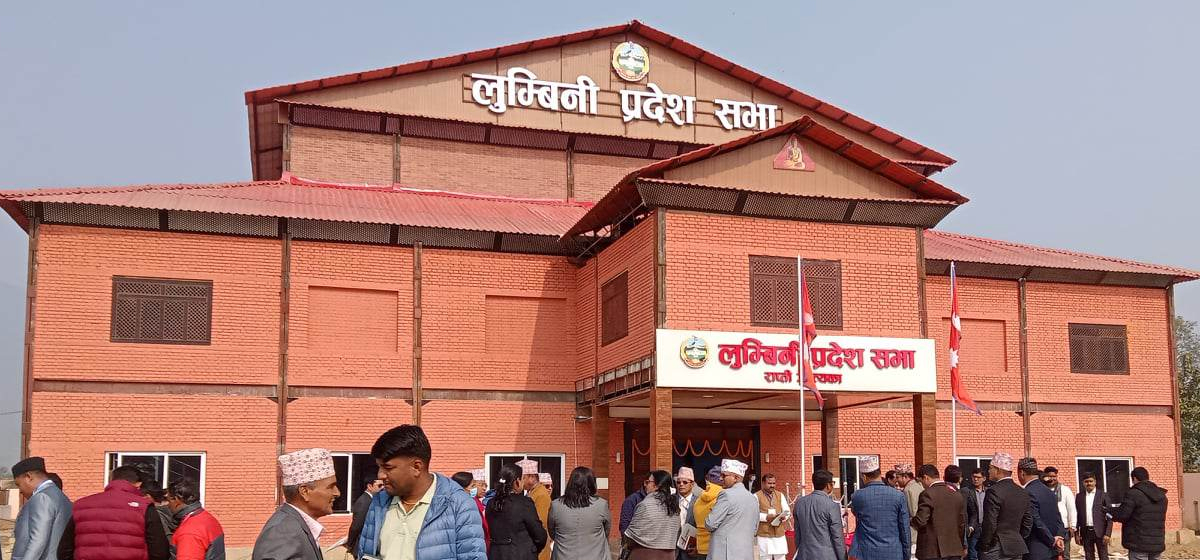
OR
Huge difference in budget for construction of similar classrooms
Published On: September 24, 2018 06:30 AM NPT By: Rudra Pangeni | @rudrapang
Classrooms being built using regular govt grants are not quake-resilient
KATHMANDU, Sept 24: Classrooms that the government is building in quake-hit districts will have different safety standards, thanks to difference in budget disbursements to two different agencies overseeing reconstruction of classrooms.
According to officials, classrooms being built by respective school management committees with regular government grants lack quake-resilient features, among other safety standards. However, reconstruction of classrooms financed by development partners or donor agencies and implemented by Central Level Project Implementation Unit (CLPIU) -- a special agency for rebuilding schools under National Reconstruction Authority (NRA) -- are safer because they have more budgets for the same design. This means the implement agency can use quality materials and allocate separate budget for supervision of construction works.
CLPIU projects have added 1 percent contingency fund in each project for the fund of construction supervision for CLPIU engineers, Center for Education and Human Resource Development (CEHRD), previously Department of Education, has deputed engineers only in few districts. Also, it lacks budget for supervision of construction works.
The budget allocation by CLPIU for school buildings with two, three, four and six classrooms are Rs 2.39 million (truss structure), Rs 3.6 million (truss structure), Rs 6 million (RCC structure) and Rs 10.5 million (RCC structure), respectively.
Grants distributed by CEHRD for two classroom block (of truss) is Rs 1.60 million and three classroom block of truss is of Rs 2.1 million. Similarly, it gives grants for Rs 3.6 million for a block of four rooms (RCC), Rs 4.8 million for a block of six rooms (RCC) and Rs 5.7 million for eight-room block (RCC).
Grants for blocks having three, six and eight classrooms were distributed in Fiscal Year 2015/16 only.
Though CEHRD grants are to be matched with community participation worth a minimum of 5 percent of the total budget, the concept has not worked in most of the cases particularly where the communities are from marginalized groups or in places parents do not send their wards to community schools.
The government has built 5,296 classrooms in 31 quake-hit districts, including 14 worst hit districts through its regular grants in FY2015/16, while 3,804 classrooms were constructed in FY2017/18. Though disbursement of grants for classrooms was discontinued in FY 2016/17, it resumed in the following year, according to data maintained by CEHRD.
Government engineers say building a quake-resilient classroom is almost impossible with low budget. Such works only put school children in risk, they added.
Communities look for cheap truss set of 1,350 kg, instead of a stronger 2,350 kg set for a two-room building as their intent is to utilize the grants anyhow, said Ram Prasad Acharya, Project Coordinator of Gorkha-based District Level Project Implementation Unit under CLPIU. “Construction of quality classrooms is not possible with such low budget when local community cannot arrange needful resources,” added Acharya, who is also a former district education officer.
Officials at CEHRD complained that Ministry of Finance did not listen to their plea to increase grants for quality works. Building classrooms in difficult topography is costlier because of additional transportation costs to ferry construction materials and higher wages of construction workers. But the grants that CEHRD has been distributing for the past decade is almost the same for all places.
Deepak Sharma, the spokesperson of CEHRD, said that the grants provided for construction of classrooms are distributed, expecting a sizable contribution from the community (5 percent of total projects cost is required minimum). "Everybody knows the low funding does not yield good results. But we are continuing it every year," he added.
Only one or two engineers in each district are recruited for construction supervision. The government has given continuity to distribution of grants for construction of classrooms even after the earthquakes that damaged more than 8,000 schools in 31 districts despite knowing that the modality was not working properly.
"Chances of building unsafe classrooms with insufficient budget are high," Sharma said, adding that their calls to increase budget went unheard.
In a review report of School Sector Reform Plan program in 2016, World Bank, one of the key development partners for the program, had also pointed out variations in the quality of classroom construction. The report stated: “There is also considerable variation in the quality of construction. The government is trying to build lots of new spaces, emphasizing quantity instead of quality.”
Sharma said that grants for construction of classrooms are now handed over the local units. "But construction of classrooms for last year's budget is going on different parts of the country as the grant is of multi-year nature," he added.
This means safety standard has not been considered while building classrooms. A total of 15,230, 4,410 and 9,100 classrooms were built in FY2015/16, FY2016/17 and FY2017/18, respectively.
"Our buildings are structurally strong and can withstand earthquake of up to 7.9 magnitude," CLPIU chief Im Narayan Shrestha, said.
CLPIU is busy rebuilding 7,553 school buildings as few hundreds of schools have been merged with nearby schools.
“We recently completed construction of an 8-room block of concrete structure. Buildings with budget of Rs 9.3 million are safer compared to previous buildings built with low government grants,” Radhakrishna Shrestha, headmaster of Melamchi-based Indreshwari Secondary School, told Republica over telephone.
You May Like This

July 5: 6 things to know by 6 PM today
Your daily dose of missed important news of the day. ... Read More...

Rs 141b for post-quake reconstruction
KATHMANDU, May 30: The government has earmarked Rs 141 billion in the new budget for post-earthquake-recovery programs across the earthquake-affected... Read More...

Eight local levels unveil policy and programs in Khotang
KHOTANG, June 25: Eight local levels including two municipalities in Khotang district on Thursday unveiled their policy and programs for... Read More...


Just In
- Resignation of JSP minister rejected in Lumbini province
- Russia warns NATO nuclear facilities in Poland could become military target
- 16th Five Year Plan: Govt unveils 40 goals for prosperity (with full list)
- SC hearing on fake Bhutanese refugees case involving ex-deputy PM Rayamajhi today
- Clash erupts between police and agitating locals in Dhanusha, nine tear gas shells fired
- Abducted Mishra rescued after eight hours, six arrested
- Forest fire destroys 13 houses in Khotang
- First meeting of Nepal-China aid projects concludes















Leave A Comment